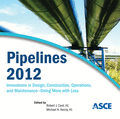Seismic Fragility Evaluation of Water Pipelines: Part 1—Current Practice
Publication: Pipelines 2012: Innovations in Design, Construction, Operations, and Maintenance, Doing More with Less
Abstract
Assessment and management of seismic risk of lifeline infrastructure has been receiving increased attention in recent years. Estimation of the seismic risk is imperative to minimize damage, service interruptions and loss of lives in the event of a seismic event and to plan for emergency recovery. Seismic risk is typically expressed in the form of seismic fragility curves to quantify seismic damage estimates as a function of a select seismicity parameter representing the level of seismic intensity. For pipelines, these fragility curves would depend on the joint types and characteristics, especially the axial, translational, and rotational flexibility. Considering the types of joints, pipelines could be classified into two major groups: segmented (flexible joints); and continuous (rigid joints). Segmented pipelines would include bell and spigot, and coupled joints. Continuous pipelines typically have welded, flanged or fused joints. The most commonly available fragility formulations for pipelines are based on damage and repair data collected after past earthquakes on segmented pipelines, and are primarily empirical. Since continuous pipelines typically perform better in a seismic event, direct damage data available from past earthquakes on continuous pipelines is limited. Therefore, fragility formulations for continuous pipelines are typically developed using damage data collected on segmented pipelines and modified to reflect the seismic performance of continuous pipelines in practice. This provides a reasonable approach to estimate seismic risk and has been proposed by the American Lifeline Alliance (ALA 2001) for water pipelines. A disadvantage of this approach is that it fails to provide a mechanism to account for variability in design codes, regulations, requirements, and practice. Analytical, numerical, and expert elicitation approaches are available in literature and are implemented in risk assessment guidelines for dams (U.S. Department of Interior, Bureau of Reclamation 2011) and nuclear facilities (U.S. Nuclear Regulatory Commission 1983). This paper presents a brief literature review of the available approaches to develop seismic fragility formulations for water pipelines. Based on this review, a framework for a simple approach applicable for both segmented and continuous pipelines will be presented in a companion paper planned for Pipelines 2013 conference.
Get full access to this article
View all available purchase options and get full access to this chapter.
Information & Authors
Information
Published In
Copyright
© 2012 American Society of Civil Engineers.
History
Published online: Nov 9, 2012
ASCE Technical Topics:
- Disaster risk management
- Earthquake engineering
- Engineering fundamentals
- Geotechnical engineering
- Infrastructure
- Joints
- Pipe joints
- Pipeline management
- Pipeline systems
- Pipelines
- Risk management
- Seismic effects
- Seismic tests
- Structural engineering
- Structural members
- Structural systems
- Tests (by type)
- Water and water resources
- Water management
- Water pipelines
Authors
Metrics & Citations
Metrics
Citations
Download citation
If you have the appropriate software installed, you can download article citation data to the citation manager of your choice. Simply select your manager software from the list below and click Download.
